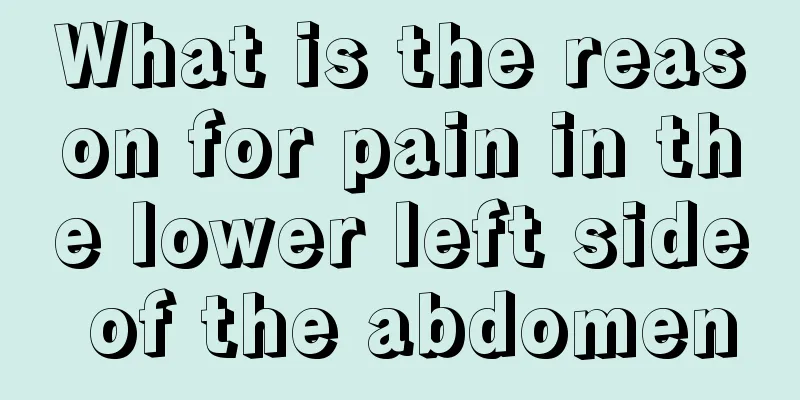What is the reason for pain in the lower left side of the abdomen

|
Eating an upset stomach or eating too cold food may cause stomach pain, but generally few people will experience this symptom. If you feel pain in the lower left abdomen without any carelessness, you need to determine whether it is dull pain, stabbing pain or dull pain. Different pains will cause different symptoms, which are usually related to gallbladder and liver inflammation. Everyone has experienced abdominal pain to some extent. When abdominal pain occurs, the most concerning question is why it occurs? Is abdominal pain serious? The location of abdominal pain is the main condition for determining the cause of the disease. Abdominal pain usually refers to pain in the front of the body, from the lower edge of the ribs to the pubic bone. Generally speaking, pain can be divided into two types: dull pain and sharp pain (hernia pain). Dull pain refers to a dull pain, which is mostly caused by pain in organs or internal organs; sharp pain refers to very obvious pain, and the patient can clearly know the location of the pain, which is usually related to obstruction of the duct, such as bile duct stones and intestinal obstruction. Pain in the lower left abdomen In most cases, there is a corresponding relationship between the abdominal lesions and the location of the abdominal pain. Generally, according to the location of abdominal organs, the abdomen can be divided into four areas with the navel as the center: upper right, lower right, upper left, and lower left. Depending on the location of abdominal pain, it can be divided into upper left abdominal pain, upper right abdominal pain, lower left abdominal pain, lower right abdominal pain and central abdominal pain. If the pain is in the right upper abdomen, you need to consider problems with the liver, gallbladder, bile duct, pancreas, duodenum, right kidney, and right large intestine; if it is pain in the right lower abdomen, you need to think about the cecum, appendix, right ovary and fallopian tube, right ureter, etc.; if it is pain in the left upper abdomen, it may be caused by the stomach, spleen, pancreas, left kidney, and left large intestine; if it is pain in the left lower abdomen, it may be caused by the sigmoid colon, left ovary and fallopian tube, left ureter, etc.; if it is pain around the navel, it mainly indicates a small intestine disease. In addition, sometimes there may be widespread pain throughout the abdominal cavity. This is usually caused by inflammation of the peritoneum due to irritation for some reason, such as ulcer perforation, ectopic pregnancy rupture, and internal bleeding. It is worth noting that some abdominal pain will shift with the influence of the lesion. For example, the pain starts in the center of the upper abdomen, gradually moves to the lower right within 24 hours and becomes more and more painful. This is an important sign of appendicitis. The pain was originally in the upper right corner and gradually extends to the bottom of the right rear shoulder blade. This may be a problem with the gallbladder or gallstones. Do not ignore clues that help with diagnosis. The causes and effects of abdominal pain can be mild or severe. When abdominal pain occurs, in order to accurately grasp the cause, patients should pay more attention to the pain condition to facilitate the doctor's diagnosis, including the location of the pain, time, nature of the pain, whether it is accompanied by other symptoms, factors affecting the change of pain... etc. Whether the pain in the lower left abdomen is accompanied by other symptoms is also one of the key points in determining the cause of the disease. For example: diarrhea may be caused by gastrointestinal inflammation; constipation may be caused by fecal obstruction; vomiting should be considered as intestinal obstruction or inflammation; changes in bowel habits may be caused by lesions in the large intestine; jaundice, fever and other symptoms may be caused by bile duct or liver lesions; frequent urination, difficulty urinating, nocturia, etc. should be considered as problems with the bladder or urethra. These different symptoms that appear along with the pain can help to distinguish the true cause of the abdominal pain. |
<<: What are the symptoms of colitis?
>>: What are the symptoms of acute enteritis
Recommend
What is the highest cooking oil temperature?
Usually, you should pay attention to controlling ...
Daily health tips?
Health is very important to everyone, but with th...
What are the late symptoms of rectal cancer
There are many symptoms of late-stage rectal canc...
What are the effects and functions of Xanthium sibiricum leaves
The main effect of Xanthium sibiricum leaves is t...
What to do if scraping causes pimples
Gua Sha has many functions such as treating disea...
How to repair a cracked walnut?
Walnuts are nuts that everyone has eaten, and the...
The relationship between lung cancer and smoking
The exact cause of lung cancer is still unknown. ...
What is the difference between mung bean sprouts and soybean sprouts?
Soybeans and mung beans are both very common thin...
How much do you know about the cause of hamartoma
How much do you know about the cause of hamartoma...
The hazards of bladder cancer that need to be taken seriously
Bladder cancer is a malignant tumor that grows in...
What are the dangers of severe iron deficiency anemia?
The harm of severe iron deficiency anemia is that...
Find out if ovarian cancer can be cured
Ovarian cancer is a rare malignant tumor in gynec...
Can laryngeal cancer be cured
The main symptoms of laryngeal cancer are hoarsen...
What are the common symptoms of excessive coldness in the human body
The human body likes warmth and not cold, so many...
What are the functions of calcium and magnesium tablets
With the continuous improvement of living standar...









